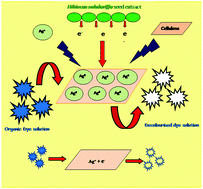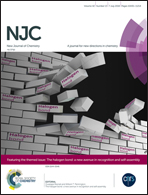Green synthesis of silver nanoparticles supported on cellulose and their catalytic application in the scavenging of organic dyes
Abstract
Water pollution caused by dye effluents from different industrial sources has become a major source of concern for the scientific community. They cannot be removed through traditional waste water treatment procedures. The present work describes a green method for the synthesis of silver nanoparticles supported over cellulose extracted from Hibiscus sabdariffa for the catalytic degradation of hazardous dyes. In addition the aqueous portion of the seed extract of Hibiscus sabdariffa is used as the reducing agent for the synthesis. The nanoparticles are characterized by UV, XRD, FTIR, FETEM and SEM. FETEM analysis shows the formation of evenly distributed silver nanoparticles supported over cellulose with an average size of 4 nm. The synthesized catalyst shows excellent activity against several organic dye solutions all of which were found to be completely decolourised within one hour of reaction. In addition, the catalyst was easily separated through centrifugation and recycled up to several times without significant loss of activity.



 Please wait while we load your content...
Please wait while we load your content...